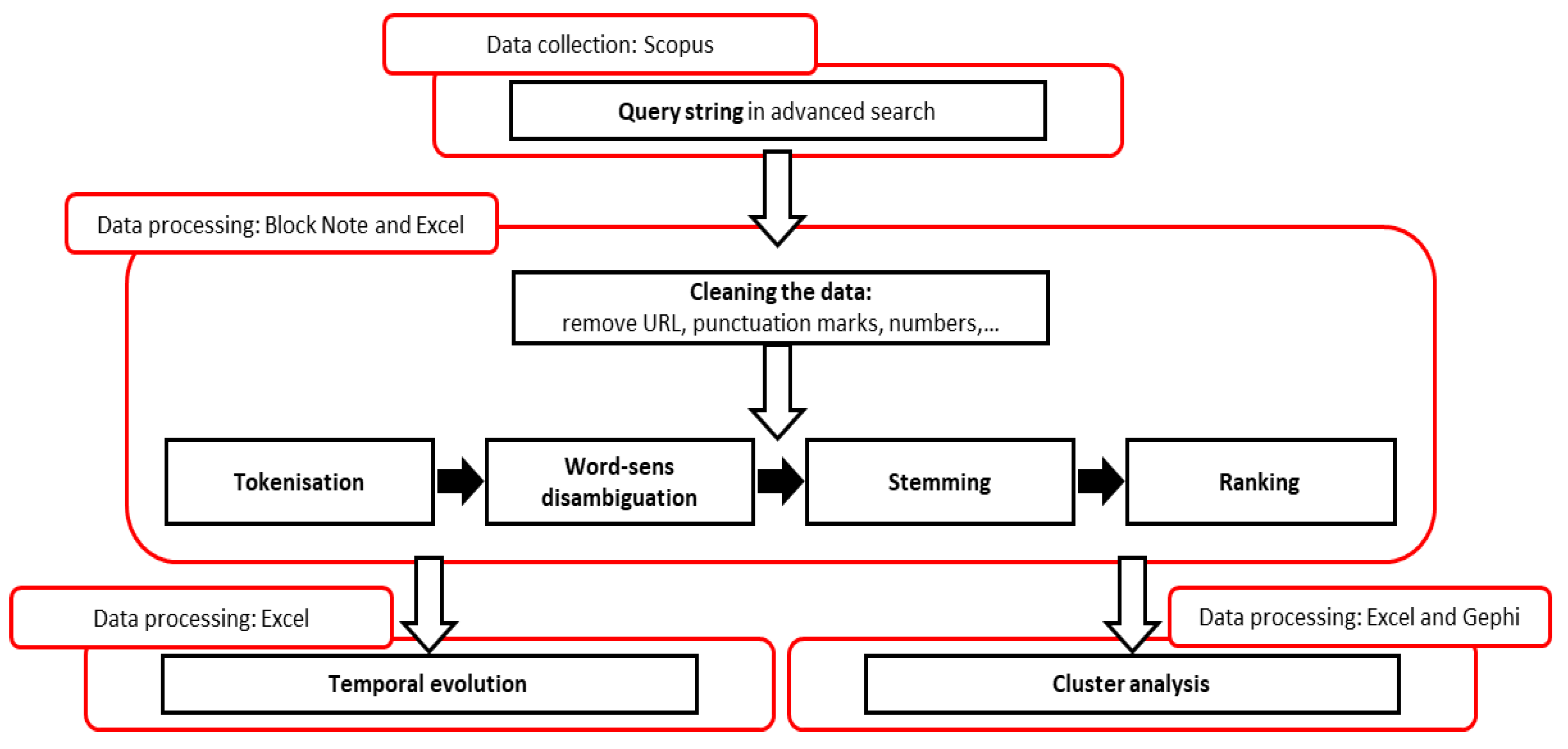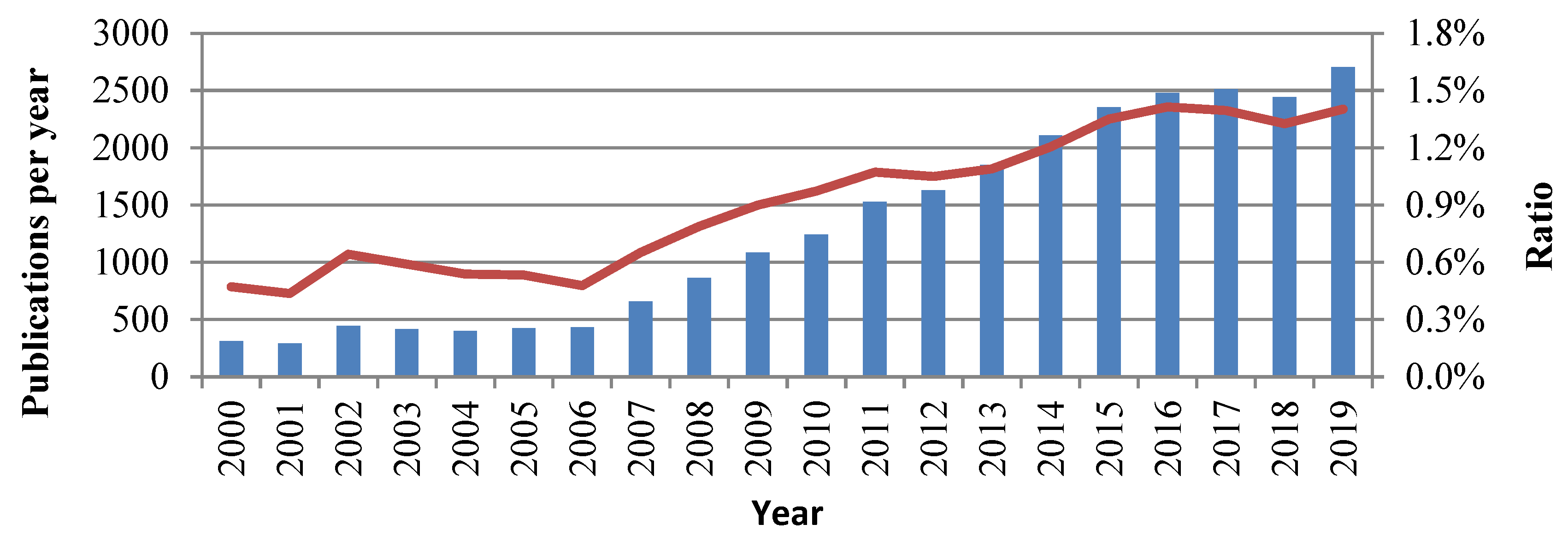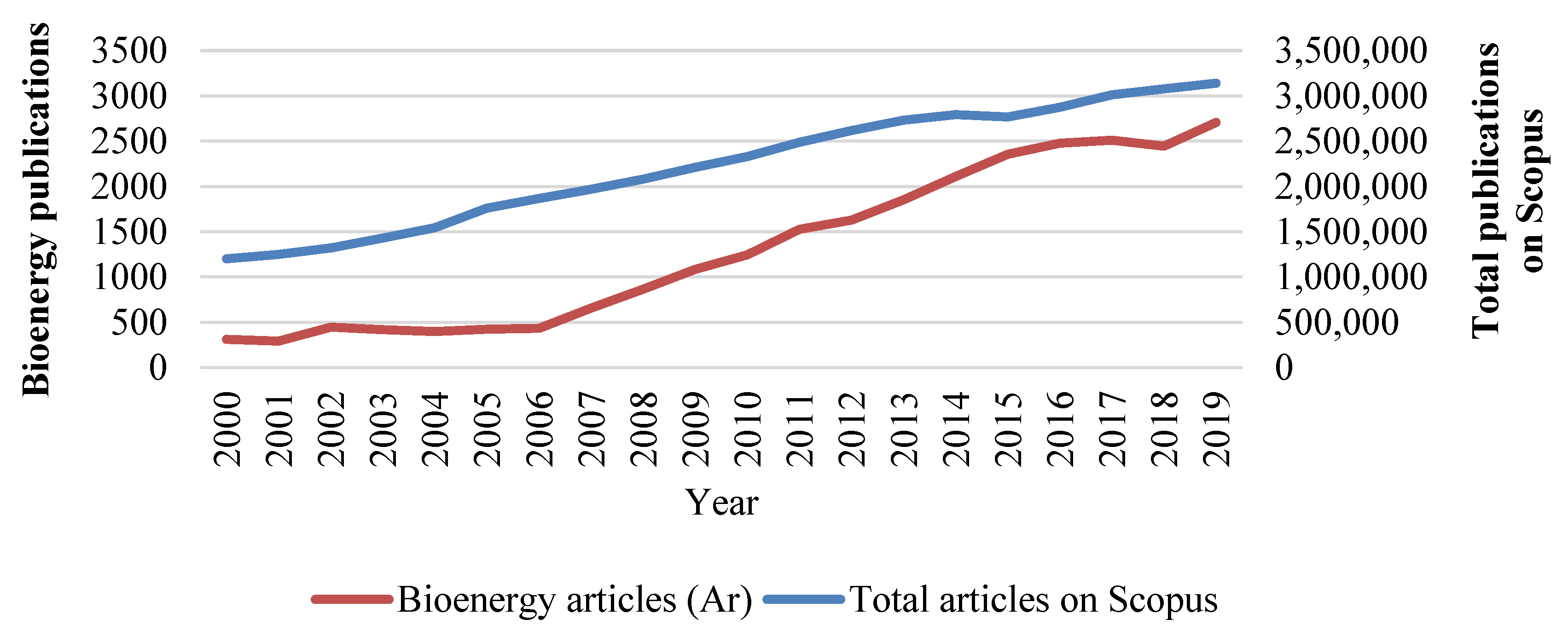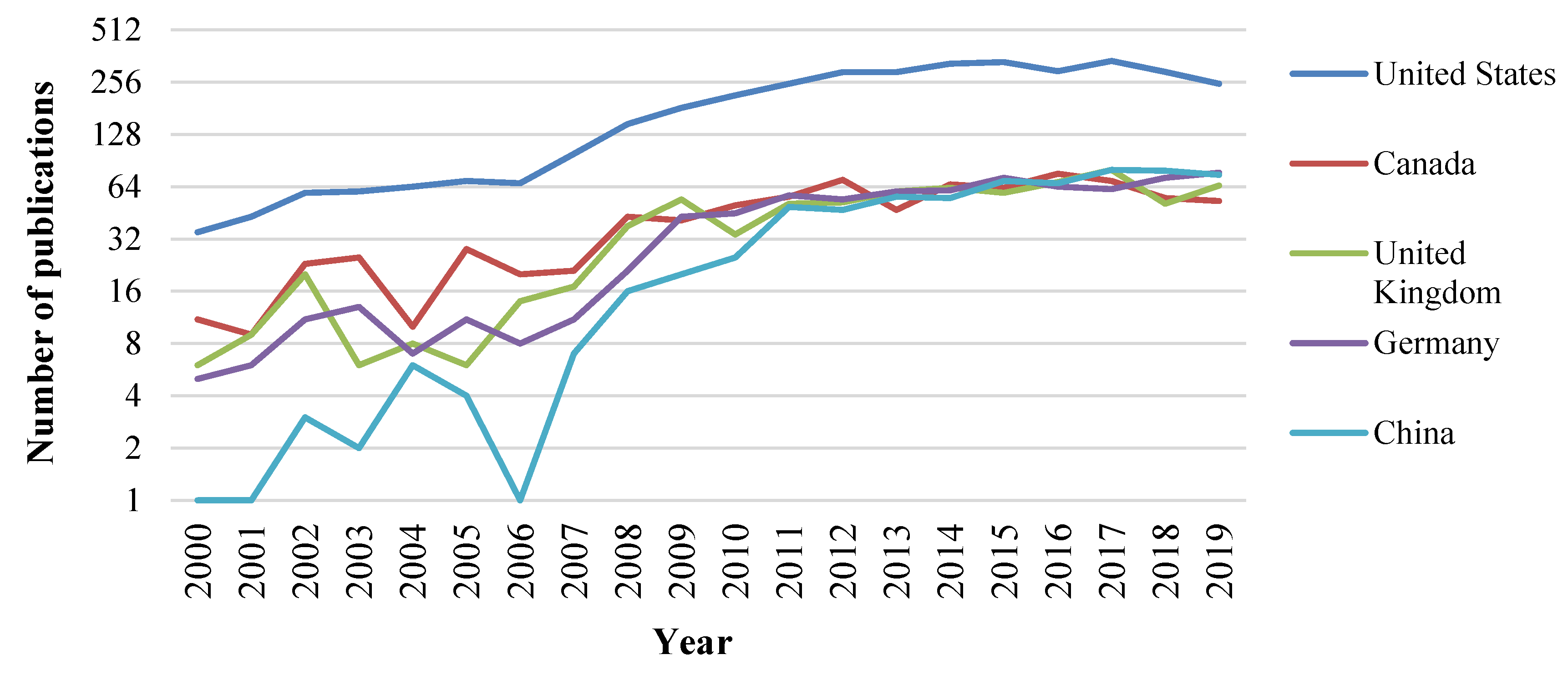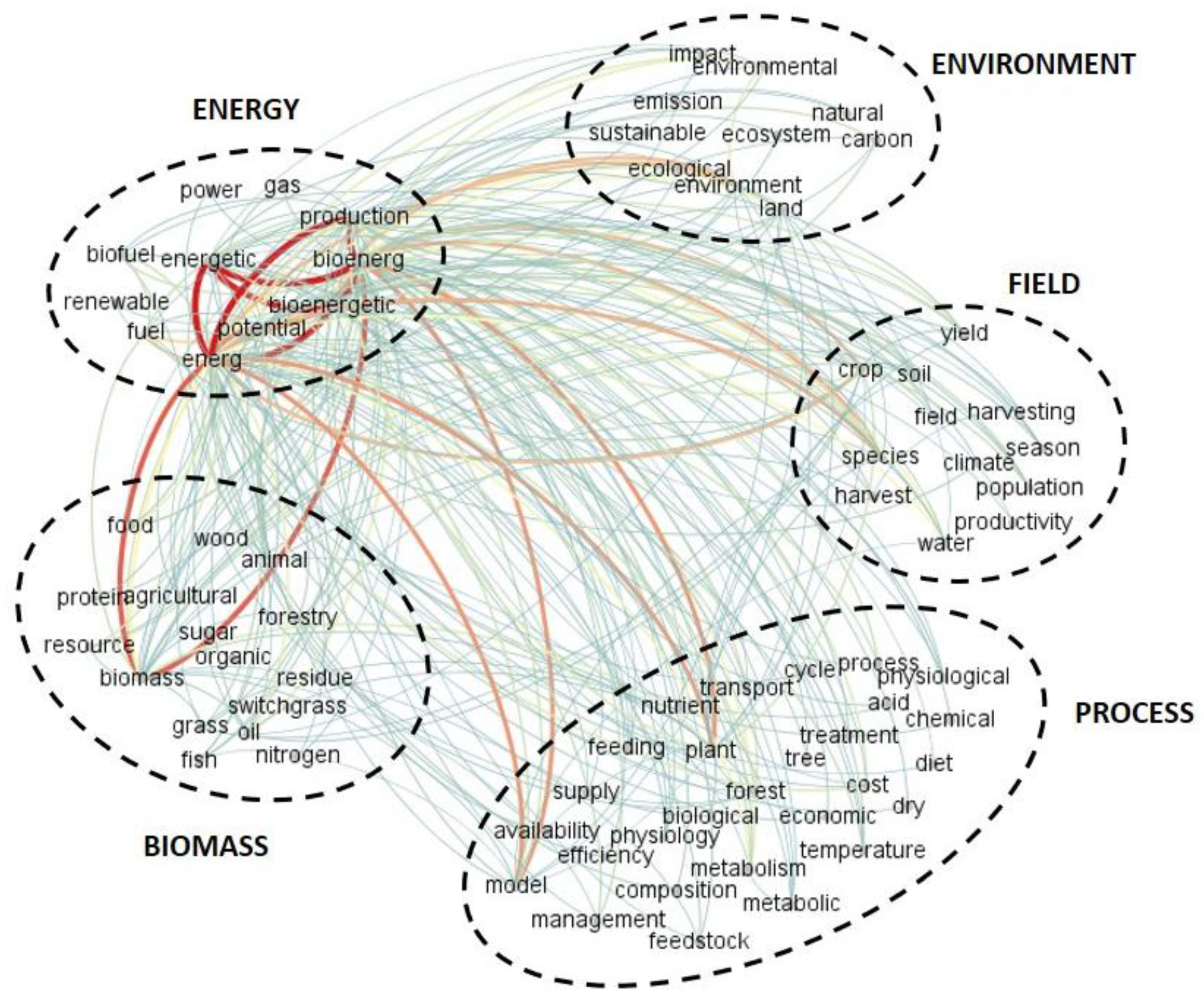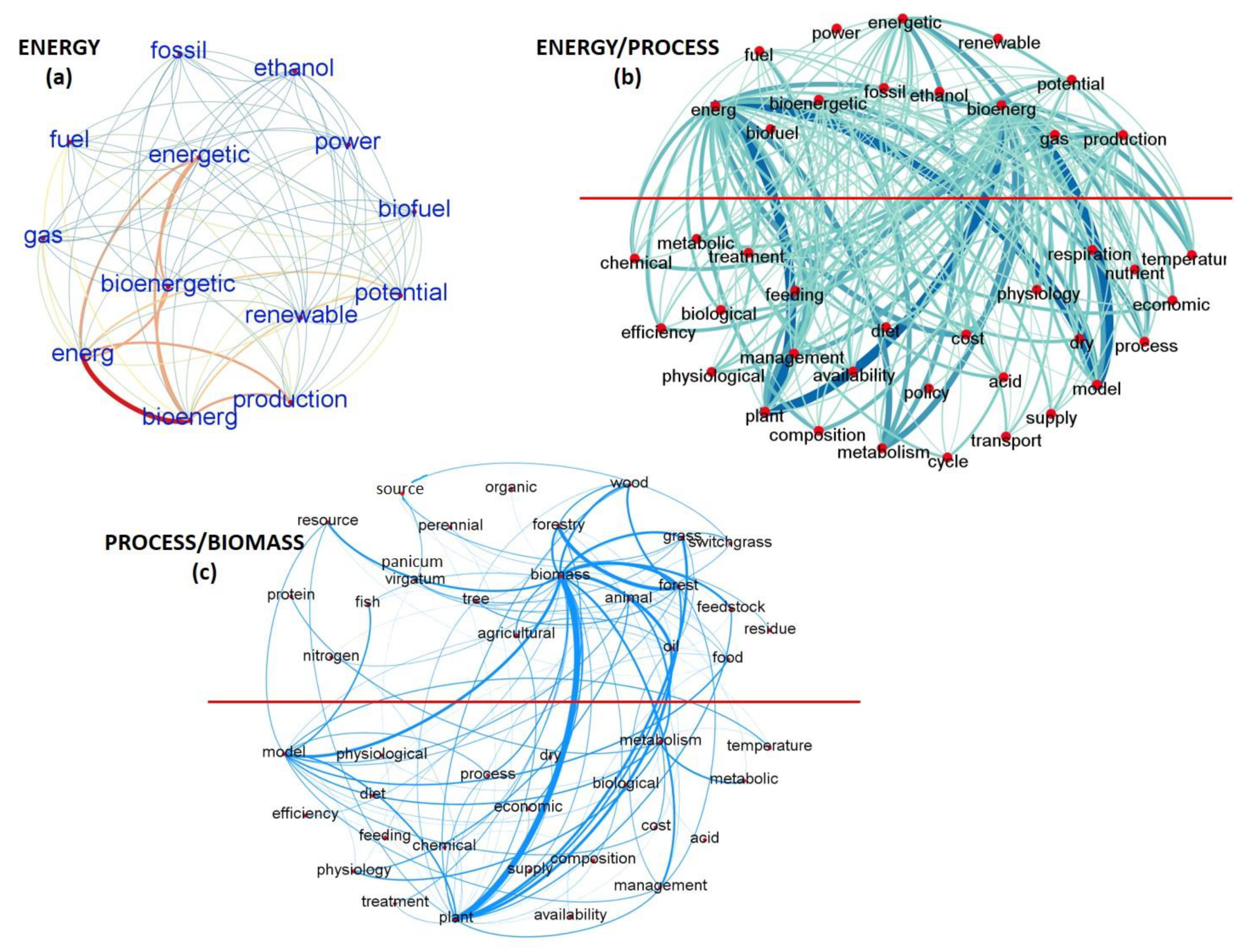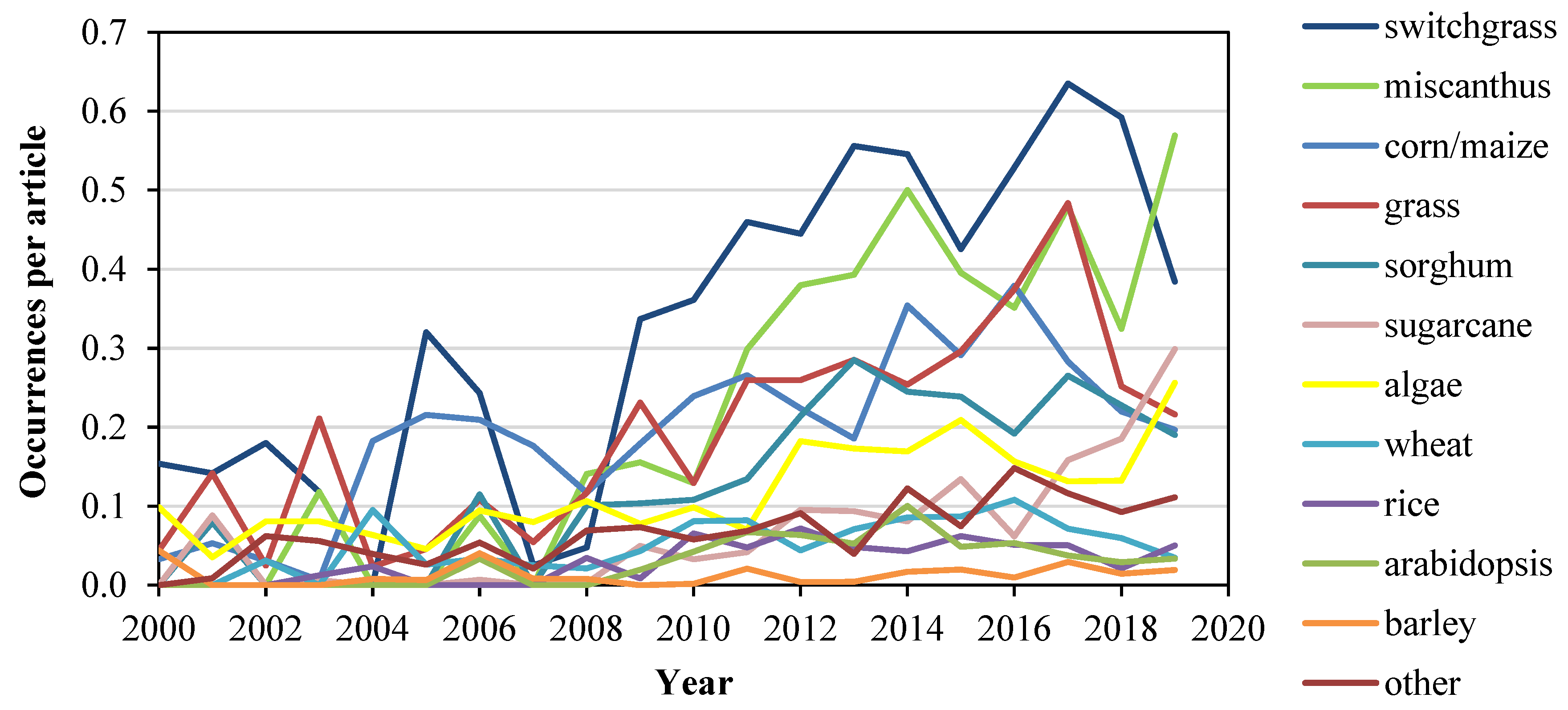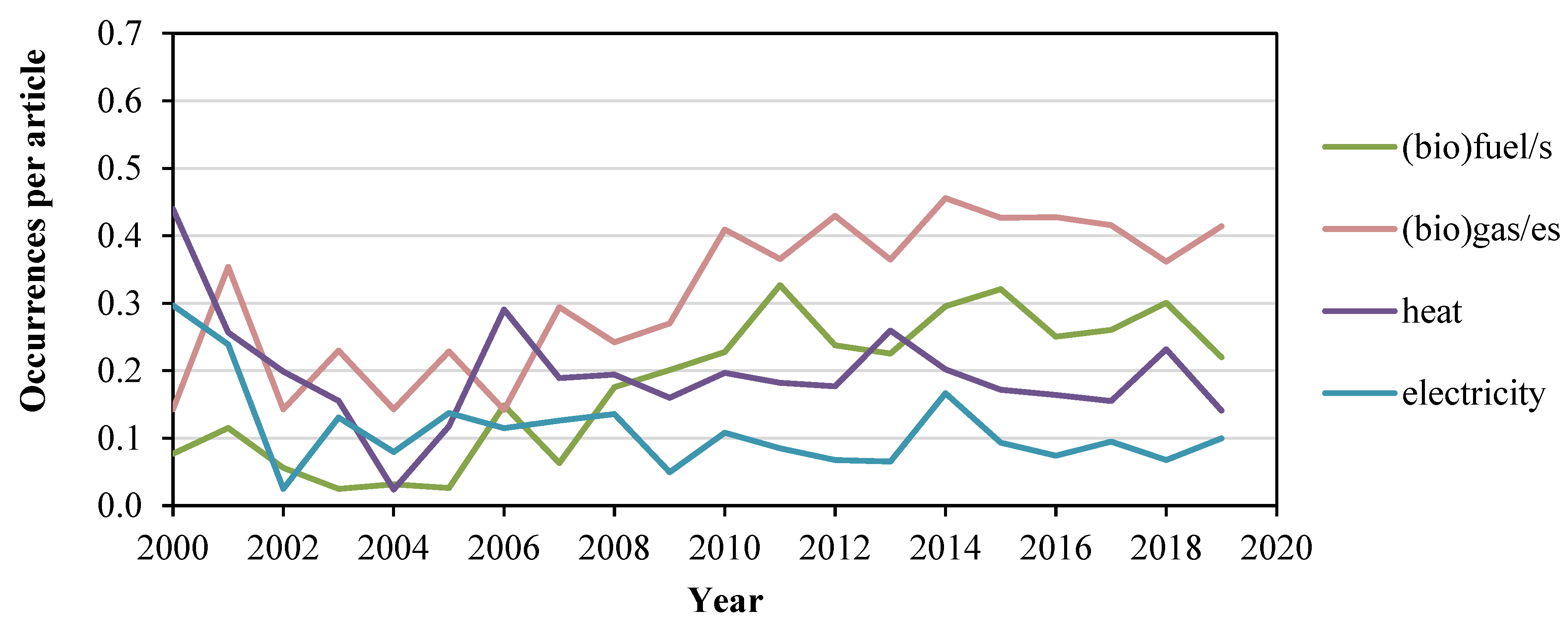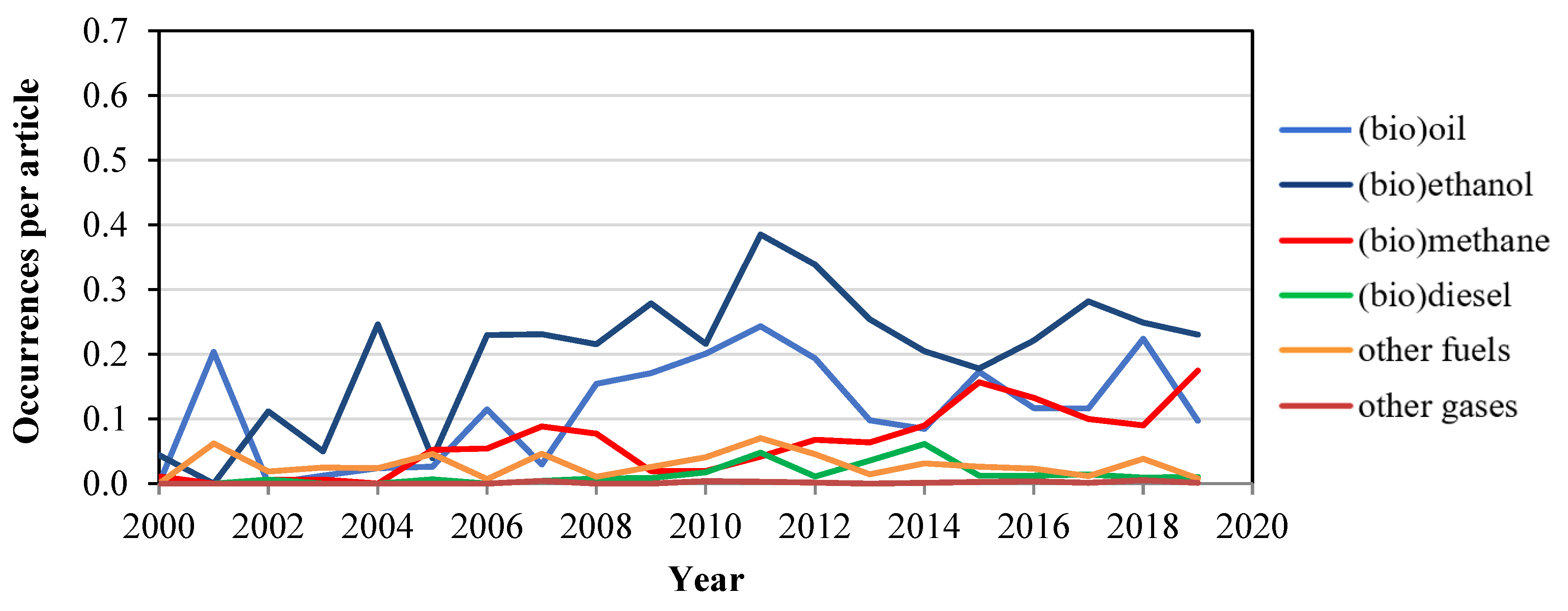1. Introduction
Bioenergy is renewable energy derived from the treatment of several types of organic sources, which are generically named biomass [
1,
2]. Biomass is biological material derived, either directly or indirectly, from the transformation of solar energy into chemical energy [
3]. It may be constituted of wood, forestry waste, crop residues, manure, urban waste, food industry residues, and the many by-products of agricultural processes [
4,
5,
6,
7]. International organizations and national governments are increasingly committed to pursuing environmental sustainability policies, setting even more ambitious targets for reducing pollution and the impact of human activities [
8,
9]. The production of bioenergy obtained from natural and agro-industrial sources represents one of the most critical points of this path [
10].
The European Union (EU) has included, in their Sustainable Development Goals (SDGs), “… 7. Affordable and clean energy…”; specifying as indicator “… 7.2.1 Renewable energy share in the total final energy consumption…” and “… 7.a.1 International financial flows to developing countries in support of clean energy research and development and renewable energy production, including in hybrid systems…” [
11]. The EU, in the “Renewable Energy Regulation”, has established the goal of 32% of energy production from renewable sources by 2030 and reducing greenhouse gas emissions by 40% compared to 1990 [
12].
In 2016, bioenergy is the most significant renewable energy source globally, covering 70% of the energy production by renewable sources. In every continent, biomass is the most important renewable energy source; it accounted for 40% of the energy in Oceania and almost 96% in Africa [
13]. Biopower (or electricity from biomass) is the third largest renewable electricity generation source, with a share of 571 TWh of electricity produced. Asia is the leader in the sector, with a share of almost 40% of electricity from biomass produced [
13]. In the transport sector, the primary renewable sources are liquid biofuels. From 2000 to 2017, biofuel production registered a significant growth: From 16 to 143 billion L. The 86% of the production of biofuel and bioethanol is concentrated in the U.S. and Brazil, with a production share of 87% [
13]. Biofuels could help reduce greenhouse gases and many countries have set targets for the production and use of these resources. Ahorsu et al. [
14] discussed the relevance of biomass for different generations of biofuels, also showing the main bioethanol producers: USA, Brazil, Europe, China, and Canada.
The widespread use of biomass determines numerous research areas for each phase of the energy supply chain: Biomass production, transport [
15,
16], treatments and digestion [
17], energy production [
18] and distribution [
19], and plant planning and management [
20,
21], as well as the social, economic [
22], and environmental [
23] impacts that the use of biomass implies. Many review articles have been written from 2016 to 2019 to gather the periodical progress in the topic and identify possible future goals in the research. Long et al. [
24] reviewed the results of previous studies that had investigated biomass resources and the estimation of their bioenergy potential, finding values of energy potential for 2050 between 96 and 161 Exajoule (EJ). Ferrarini et al. [
25] assessed the potential impact of bioenergy buffers, linear areas placed around cultivated fields and watercourses with perennial herbaceous crops or wood biomass, and the biomass supply chain on ecosystem services. Pulighe et al. [
26] studied the exploitation of marginal lands in the Mediterranean area as lands to cultivate energy crops. Authors examined the environmental impact of crops in order to assess the ecological costs of cultivations: Mekonnen et al. [
27] quantified the consumption of green, blue, and gray water of global crop production for the period 1996–2005.
The research has revealed that the long-term exploitation of bioenergy buffers on previous croplands is more advisable than on grasslands, in order to sustains the long-term provision of multiple ecosystem services: climate, water quality, biodiversity regulation, and soil health. Quadir et al. [
28] presented a series of case studies to show the potential economic and environmental benefits of restoration of salt-affected lands. These areas can be dedicated to food production with particular crops, or to bioenergy crops. Kluts et al. [
29] reviewed European land studies on bioenergetic potentials and suggested that a more comprehensive approach, combining energy crop production with land demand for food/feed, is necessary for the identification of sustainable courses for European bioenergy production requires a more integrative approach, combining land demand for food, feed, and energy crop production. Kuhmaier and Erber. [
30] reviewed the research trends regarding the comminution and transport of forest biomass in Europe. According to their review, future research should be focused on customizing the product quality, taking into consideration the user’s requirements and on developing simulation and automatization tool for the co-ordination of chippers and trucks by simulation and automatization tools. Ba et al. [
31] focused the attention on the Operations Research perspective studying recent research on models for biomass supply chains models and underlined the importance of multi-disciplinary research teams with the contribution of industrial engineering departments. Pari et al. [
32] studied the harvesting technologies available in Europe to manage and take advantage of pruning. These residues could power approximately 200–500 kW electric power plants, with an annual output of 0.8 TWh. Garcia et al. [
33] evaluated the biomethane potential and the chemical characteristics of a large number of organic biomasses obtained in the agro-industrial sector. Balussou et al. [
34] analyzed possible future developments of the German biogas plant capacity up to 2030, taking into consideration technical, economic, and normative conditions, underlining how this sector is strictly connected to political choices. The model results show rapid growth of small-scale manure plants and large-scale bio-waste plants in the German biogas market. Scarlat et al. [
35] studied the biogas market in Europe (in particular, biofuels), analyzing production and consumption trends. Subsequently, they examined a model on a European scale to quantify the biomass potential deriving from livestock activities and the relative optimal location of the exploitation plants [
36]. The theoretical biogas potential of manure was estimated, according to the analysis, at 26 billion m
3 biomethane, while the realistic biogas potential, counting on collectable manure, was assessed at 18 billion m
3 biomethane in Europe. These values are compatible with the construction of 13,866–19,482 new biogas plants could be built in Europe, with a total installed capacity between 6144 and 7145 MWe, and with an average capacity between 315 and 515 kWe. Seay et al. [
37] reviewed the latest research in the supply-chain, process simulation, discrete event simulation and risk assessment into a sustainable point of view for integrated biorefining. Manfren et al. [
38] presented a selection of currently available systems for the planning and design of distributed generation, and analyzed them together their opportunities in an optimization framework; they determined the optimal solutions for providing energy services through distributed generation by adopting a multicriteria perspective. Particular attention should be given to fuel consumption due to biomass transport: Ruiz et al. [
39] quantified that the maximum cost of logistics is 11.05 € per ton. An analysis of the Italian situation of biogas plants was presented by Benato and Macor [
40]; they investigated the construction and operation management costs of six plants and measured the composition of the emissions produced.
Preliminary models which are able to perform the described procedure have been implemented and are currently being tested. McCormick et al. [
41] presented an overview of the bioeconomy and bioenergy, examining it from a political point of view. They focused on two important topics: the involvement of communities and stakeholders in the decisional process and huge attention by the government and industry to innovation, in order to achieve sustainable development of the bioeconomy. Bioenergy research is inter-disciplinary, with connections in many different areas. Indeed, the published articles affect specific sectors in many journals. The various and numerous publications in the sector require a systematic and updated bibliographic review, which is the focus of this study.
Due to the vastness and the importance of the topic, the analysis was carried out using a quantitative method based on text mining techniques, following the guidelines presented by Cogato et al. [
42]: (i) Inter-disciplinary, studying the topic from a general point of view; (ii) clearly communicating the state-of-the-art and the research gaps; and (iii) supporting the study and work of the researchers and stakeholders. The use of bibliometric analysis to describe publications trends is widespread also in the bioenergy sector: Weinand [
43] described the evolution of the research in local planning of energy system between 1991 and 2019 by analyzing 1235 articles; De La Cruz-Lovera [
44] focused attention on the contribution of international institutions in the area of energy saving, analyzing 20,095 articles on the Scopus database from 1939 to 2018. The aim of the present analysis is to provide a comprehensive review of the state-of-the-art of the literature concerning bioenergy in Agriculture and Biological Sciences field. The specific objectives of this work are: (i) Describe the temporal trend of publications over the years; (ii) identify in which field the research has been mainly directed; and (iii) analyze the most important links between topics. A quantitative analysis represents the most effective methodology to perform the above-mentioned objectives.
2. Materials and Methods
A bibliometric analysis was carried out by selecting documents indexed by the SCOPUS database, using the advanced search to define the field of interest. This allows for showing how the research has developed and changed, following changes in society and, in some cases, determining them. Given the large number of publications, it is possible to hypothesize the influences, economic trends, and/or political decisions on the subject [
45,
46].
A text mining process was used to perform the analysis. The words appearing in the title, keywords, and abstract were analyzed using the textual modification instruments in Block Note, the frequency functions in Microsoft Excel, and the graphic representation in Gephi (Gephi
® Consortium, Compiegne, France), an open-source software for network analysis. Text mining is a process which derives significant numeric indices from text by analyzing unstructured (textual) information. The statistical analysis of these indices provides the key to text interpretation, obtaining considerable and high-quality information [
42,
43,
44].
2.1. Article Selection
The analysis was based on the term “bioenergy”. To include also its derived forms, the script “bioenergy *” was used for the research on SCOPUS. With the initial examination, the program selected the articles that contain the string “bioenerg” or its derived terms (here and in the following the asterisk “*” indicate lemma declination as, in this case (e.g., bioenergy, bioenergies, bioenergetic, and so on) in the title, in the keywords, or in the abstract. Some filters were applied for a more pertinent selection of the articles. The review articles were excluded, and the field was limited at “Agricultural and Biological Sciences”. As we were expecting, many articles (more than ten thousand) resulted from the search. This reflects the great interest in the topic and the interdisciplinarity of the matter (
Table 1).
To better understand the evolution of the research, data was selected year by year, adding a time filter at the query. The script used was “TITLE-ABS-KEY (bioenerg*) AND (LIMIT-TO (PUBYEAR, 2019)) AND (LIMIT-TO (DOCTYPE, “ar”)) AND (LIMIT-TO (SUBJ AREA, ”AGRI”))”, substituting the value for the year of research. The analysis was performed from 2000 to 2019 and included a total of 9504 papers. To perform the download, data relating to the title, keywords, and the full abstract were selected and the .csv extension was chosen.
2.2. Article Elaboration
The text extracted was saved as a .txt file. The first step was tokenization, the procedure in which the sentences are broken into pieces, removing punctuation marks, hyphens, and brackets, reducing the text only to its single words. The result of tokenization was a list of single words. Further elaboration was required to convert all letters to lowercase and to identify and convert all terms that can be written in two ways (e.g., bioenergy/bio-energy or bioenergetic/bio-energetic).
The final list of terms was exported to Microsoft Excel. The software allowed us to order the terms and count how many times each one appeared. This kind of elaboration allowed us to identify the more frequent terms in each year. Using Excel, the 100 most relevant words (occurring in at least 4% of the analyzed papers) were identified and used for the subsequent analysis. Finally, the results were processed with the software Gephi (Gephi
® Consortium, Compiegne, France), which is a free tool that allows for the creation of a graphic representation of an association of terms. The representation is a graph in which the nodes are the connected terms (eventually with a specific weight) and the vectors—directed or undirected—are the connections between the terms. The conceptual flux of the analysis is represented in
Figure 1.
2.2.1. Combination Matrix
With the 100 most used terms, a word–word connection matrix was built. The matrix had 1002 cells and, so, 10,000 couples. Starting from this matrix, we built a connection matrix in which, for each couple of words {w1w2}, the number of articles that contained both the terms was indicated. The connections are not directional, as the value of {wn wm} was the same as that of {wm wn}. Moreover, the number {wn wn} was exactly the number of articles the word wn appeared in. As a result of the matrix, 4950 couples of terms were obtained; the value that corresponds to the k-combinations from a given set of n elements, with k-value of 2 and n-value of 100.
2.2.2. Clusters Definition
Cluster analysis, or clustering, is defined as the task of grouping a set of elements in such a way that the objects in the same group (cluster) share one or more features that make them more similar to each other than to those in other groups. When the object of the analysis is a multidisciplinary topic, cluster analysis makes it possible to investigate the relationship between two or more fields in which the topic is used. By clustering, the most relevant settings and connections are identified. Moreover, it is possible to describe how these rankings and relationships develop and modify over the years.
The bioenergy production phases were chosen as criteria to shape the clusters. Five clusters were identified: Environment, Field, Biomass, Process, and Energy. The number and topic of the Clusters were chosen to adequately cover all aspects of the theme, avoiding an over-fragmentation of the sets. Multiplying the number of clusters could increase time fluctuations and make it challenging to identify trends. The 100 most relevant words previously found were inserted into one of these groups, whichever was more suitable. For more specific analysis, some sub-clusters were created (e.g., crops), as type of produced energy. These groups covered very particular fields, and the included words had a very similar field of application. Some of the included lemmas were not in the top 100 by relevance but, due to their particular significance and pertinence to the sub-cluster, they were included in the analysis: This is the case of some secondary crops (e.g., rice, wheat or barley) or some energy terms (such as heat or methane). It is worth noting that alternative energy sources (e.g., wind or solar power) have not been considered in the analysis. Indeed, the occurrence of related lemmas is almost zero (<1%).
Table 2 shows the cluster composition.
3. Results
3.1. Analysis of the Trends
The first consideration concerns the number of articles published per year in the Bioenergy topic and its ratio with the total number of publications in the Agricultural and Biological Science field. As can be seen in
Figure 2, the number of publications in the field of Bioenergy registered a slight increase between 2000 and 2006, and then accelerated rapidly until 2017. In the following year, a 12% drop in publications was shown, a stable value in the last year.
The variations in the number of articles depend both on the increase in the interest of the researchers on the subject and on the overall growth in publications. To clarify this aspect, in
Figure 2, the ratio between the Bioenergy articles and total publications in the Agricultural and Biological Science field is represented. It is interesting to note that, from 2006 to 2011, the ratio between the two values tripled; indicating that, in that period, the interest in the topic Bioenergy increased. Since 2011, the ratio has been almost constant, which means that the variations in the articles on the Bioenergy topic are mainly linked to the total number of publications.
To clarify this aspect, a broader analysis was developed. On SCOPUS, articles with the string “bioenerg *” in the Title-Abstract-Keywords and the limitation of “AR” (without the restriction of the sector “Agri”) were identified. This series of articles was compared to the total number of publications in the Agricultural and Biological Science field. Results are shown in
Figure 3.
Figure 3 shows a more regular growth of both indicators. The values of articles with the term “Bioenerg*”, not limited to the “Agri” sector, have steadily increased from 2006 to 2019, except for a weak decrease in 2018. A comparable trend was shown by the ratio between the value of the same set of articles and the total articles in the “Agricultural and Biological Science” field. The diagrams obtained indicate that, between 2005 and 2006, interest in the bioenergy theme began to increase, occupying even more importance in the efforts of researchers. Interestingly, the Kyoto Protocol entered into force on 16 February 2005, so it is conceivable that it influenced the interests of researchers, encouraging them to find solutions to reduce CO
2 emissions, in order to comply with the agreement.
A further incentive may have been given by the 2009 United Nations Climate Change Conference (commonly known as the Copenhagen Summit) for climate change mitigation. Following this pattern, a slowdown starting from 2016 can be noted. The Paris Agreement in 2015 seems not have made a substantial contribution to research in the renewable energy sector. A confirmation of this trend came by comparing the publications with the term Bioenergy with the total publications on SCOPUS in the same period.
Figure 4 shows that the total number of publications has a steady but slower growth than publications with the bioenergy theme.
Another quantitative research performed was the analysis of the affiliations and the international collaborations. Countries of all the continents contributed to the publications on the theme. The United States is the most important contributor, with 39% of the total publications. The top five contributors provide about 49% of the publications (
Figure 5). Countries with the highest growth in the last 20 years were Brazil (eight publications from 2000 to 2004 and 301 from 2015 to 2019) and China (12 publications from 2000 to 2004 and 370 from 2015 to 2019).
The international research collaboration was analyzed. The most relevant collaborations are between the USA and five countries: Canada (201 articles), China (150 articles), the U.K. (106 articles), Germany (101 articles) and Australia (96 articles). Sixth and seventh positions are between the U.K. and Germany (88 articles) and Canada (71 articles) (
Table 3).
3.2. Research on Most Recurrent Terms
Using .txt files and .xlsx files, a ranking of the top words used year-by-year was created. For each term, the number of occurrences in which it was cited in the title, abstract, and keywords was calculated. The ranking is different in different years. The results regarding the words belonging to Cluster “Field” are shown in
Table 4.
To classify the terms in the two considered decades, the weighted average of the values over several years was made. For each year, the ratio between the occurrences of a term and the total number of articles in the Bioenergy field was created. The overall score of a term (Equation (1)) was obtained by the weighted mean of the values over the years, giving higher weight to the most recent years to better focus the attention on the current situation:
where
wi is the weight of the
ith year,
oi is the number of occurrences of the given term in the
ith year, and
Bi is the number of articles in the Bioenergy topic in the
ith year.
3.3. Cluster Analysis
The first 100 terms among the pre-processed ones were grouped into five conceptual clusters. The weight of a cluster was determined by the sum of the weights of the terms that belong to it. This weight was calculated using the ratio between the occurrences of the terms in a given year and the total articles in the Bioenergy topic in the same year.
The broader cluster was that with the theme “Biomass”, which included all words regarding the possible sources of biomass and their characteristics (e.g., “protein”, “nitrogen”, “organic”, “feedstock”, and so on). The most important sources of biomass in the cluster were, in descending order: food (8.2%), fish (7.7%), forest (6.0%), wood (4.6%), animal (3.3%), switchgrass (3.1%), agricultural (3.0%), and miscanthus (2.9%). Other significant clusters were Energy (24.6%) and Process (23%), as shown in
Table 5. The cluster “Energy” included the terms and the concepts linked to the step of energy production, while the cluster “Process” considered the phase of treatment of the biomass resources, including the economic and management aspects. Features regarding production and resource conditions were included in the cluster “Field”, while environmental and sustainability concepts were listed in the “Environment” cluster.
By the results of the analysis, production and treatment were the sectors in which researchers have mainly focused during the last 20 years. Considering the selected words, the sources of biomass (i.e., food, fish, wood, switchgrass, miscanthus, grass, sorghum, oil, corn, residue, panicum and maize) occupied about 37.7% of the occurrences. The terms “emission” and “greenhouse” (mainly related to the greenhouse gases) influenced the cluster for about 12.3%. In the cluster “Energy”, specific terms such as “fuel” and “biofuel” presented an impact of 6.3%; meanwhile, other topics such as “electricity” and “biogas” were not even among the most frequent words.
In the “Process” cluster, an important contribution was given by terms relating to chemical and biological aspects: temperature (8.0%), metabolism (7.2%), metabolic (5.0%), feeding (4.5%), diet (4.2%), composition (3.6%), physiological (2.7%), nutrient (2.4%), respiration (2.4%), physiology (2.2%), biological (2.2%), treatment (1.9%), and chemical (1.7%). It is worth noting that some of these terms are important parameters in the production process of biofuels and biogas: the same process is also deeply influenced by the specific implemented crops, which; however, were included in the generic “biomass” cluster for the diverse meaning and use they might have in research papers. The residual contribution consisted of technical and economic terms. The “Field” cluster was made up of terms with fewer occurrences than the others, but it indicated that there was interest in the biomass production aspects. The environmental issue seems to have had minor importance (10.5% of the total), which is likely to tend to increase in the coming years.
The percentage of occurrences of the clusters per number of articles in the bioenergy field were compared. Observing the trends over the last 20 years (
Table 6), it is noteworthy to observe that the percentage weight of the “Process” cluster has steadily decreased, from 26.5% to 21.0%. The “Energy” cluster has suffered a comparable, but less accentuated, reduction—from 25.8% to 21.5%. Both the “Field” and “Environment” clusters have been continuously growing; the cluster “Field” from 10.4% to 18.6% (therefore, an increase of about 79%), and “Environment” from 7.3% (the 2001 value was taken, as that in 2000 seemed to be out of scale) to 11.8% (therefore, increasing by 62.3%). It appears that environmental and sustainability issues have been of increasing interest in research, a consequence of the ecological policies promoted by national governments and international institutions.
3.4. Interrelationships Between Terms
The objective was to provide specific information on how main topics belonging to the same or different clusters were addressed together, so interrelations of the terms were studied. Therefore, each of the already mentioned 100 most frequent words in the title, keywords, and abstract section was coupled with each of the remaining 99 words, generating 4950 possible combinations. Such combinations were studied in terms of occurrences on analyzed 20 years bibliography and graphically represented, generating a very complicated net of relationships (
Figure 6). The same combinations occurrences were also represented in a table format (
Table 7).
Given the research theme, the “Energy” topic was expected to include the terms with the highest number of co-occurrences. It presented the maximum value of co-occurrences both between terms inside the cluster and terms belonging to different clusters. Excluding these groups, the cluster with the maximum number of co-occurrences was “Biomass”. This result was also due to the large number of terms belonging to this cluster, including all sources of biomass and energy. The group of words with fewer relationships with other terms was the cluster “Environment”, which also presented the minimum value of connections between words inside the same cluster (
Table 7).
To better understand the connections between the terms,
Figure 6 was exploded, focusing the view on pairs of groups of words. In the first one (
Figure 7a), the statistical analysis highlighted that the scientific community has studied every type of energy achieved by biomass.
The analysis of single couples of terms, without considering the cluster they belong to, allowed to show which topics were the most related. The following schemes were elaborated by taking the first 30 couples of terms by relationships. Trivial or non-relevant couples were excluded; for example, “environment–environmental”, “fuel–biofuel”, and all those that contained the terms “energy” or “bioenergy”. The results are summarized in
Table 8.
3.5. Temporal Comparison of Related Terms
To describe the evolution of research publications in the bioenergy sector, groups of words with very particular bonds were taken. These groups were constituted by terms that expressed alternative solutions in the study and, by analyzing the variations with which these solutions are cited in the articles, it is possible to understand in which direction the research was addressed.
The first specific cluster considered was related to “Crops” (
Figure 8), which included potential biomass sources from agricultural activities. Considering the trend over the last 20 years, a temporal analysis allowed us to identify if there were crops that have gained interest as sources of biomass for energy purposes and if there were others that, on the contrary, are considered less valid at present than in the past.
The first general consideration was that citations of crops per article in the bioenergy theme have generally grown over the considered period. In other words, a growing attention has been paid to the selection of specific or alternative crops as potential source for bioenergy production. Above all, Miscanthus has showing the largest evolution, moving from 0 to 0.584 occurrences per article (occ/art), which signifies that there were about 0.58 citations of the term per each article considered to fall under the bioenergy theme. One other significant result is the trend exhibited by the term “sugarcane”, the ratio of which increased from 0 to 0.306 occ/art; a result that is particularly important, considering that the production of this product is mainly concentrated in developing countries. The term switchgrass was the most cited for several years (from 0.187 to 0.282 occ/art), although it registered some deep falls. Some types of crops have shown growth over time, albeit with fluctuating trends such as grass (from 0.044 to 0.221 occ/art), corn (from 0.033 to 0.202 occ/art), sorghum (from 0 to 0.195 occ/art), or algae (from 0.099 to 0.256 occ/art); trends and applications of algae were studied by Deviram et al. [
47] and by Yang et al. [
48], showing growing interest in recent years, particularly in the USA and China. Some other crops have given evidence of an initial interest, but with a loss of relevance in the last years, as in the case of wheat or thale cress (Arabidopsis). Other crops (including Arundo, Beets) have been taken into consideration; however, they still play a weak role in research publications.
The second specific considered cluster was related to “Energy produced” (
Figure 9), which included the energy forms that can be obtained using biomass. The relevance of the argument and the benefits and costs associated with each type of utilizations was studied by Guo et al., expecting a growing of the sector in the next future, in particular bioethanol and biogas [
49]. This type of analysis makes it possible to understand which kind of produced energy the publications focused on, assessing whether politics or international agreements have had an influence on the research. The occurrences of the terms “heat” and “electricity” were almost constant over the two considered decades. Excluding the first three years, which exhibited an anomalous peak, occurrences of the term “heat” moved from 0.155 to 0.145 occ/art, while the citations of the term “electricity” moved from 0.130 to 0.102 occ/art.
The slow but steady growth of the other terms related to biogases and biofuels is significant. Indeed, in the first case citations increased from 0.143 to 0.414 occ/art (i.e., with an average increase of 9.5% per year), while in the second case the number of occurrences per article moved from 0.143 to 0.378. For biofuels, a more evident growth can be recognized between 2007 and 2011 (+0.404) occ/art: Such increment might be associated to the increasing impact on economy of crude oil prices (which reached a maximum in July 2008), along with international and in particular European strategies for biofuels, published in 2006 [
50].
Biofuels and biogases are detailed also in
Figure 10. The most recurrent term in two decades of published research is ethanol, with an average of 0.200 occ/art. On the other hand, a clearly growing interest is being devoted to methane, with a number of occurrences which has moved in the last decade from 0.019 to 0.175 occ/art. Other types of fuels (such as methanol or ethylene) and other types of gases (such as propane, ethane or butane) still exhibit a minor interest for the scientific community, with a total number of citations lower than 0.025 occ/art. Development of the types of renewable sources of energy in recent years has led to specialization in their use. Biomass-derived energy is particularly suitable to be stored and used in case of requirements; more so than the electricity produced by wind farms and solar plants. Furthermore, the objectives of reducing greenhouse gas emissions due to the transport sector can be validly achieved not only by optimizing harvesting process [
51] but also by using fuels derived from biomass. These considerations could explain the growing interest in research in the biofuel and methane sector, which are adequate products for storing produced energy and fueling vehicles, and in the comparison of different ways of use of the energy produced [
52].
4. Discussion
The presented research was performed by a text-mining analysis, taking into consideration the title, abstract and keywords of every article. The most critical and frequent terms were identified and analyzed. The most significant relationships were recognized, both between specific terms and aggregated clusters.
The temporal analysis allowed us to describe the evolution of publications; in particular, which topics have gained or lost importance and which relationships have been strengthened.
4.1. Temporal Analysis of Publication Trends
Themes related to bioenergy and its production, management, and use are not recent topics in research. However, interest has risen sharply in recent years, with a growth of about 726% in publications and around 183% by weight of total articles in the Agricultural and Biological Sciences field. Research in the branch has affected every aspect related to the theme in a different way, as was shown in the cluster analysis.
Although the interest of research has been influenced by the economic and environmental policies of countries and international institutions, given the extensive range of topics, it is difficult to establish a link between single events and temporal trends. However, it is legitimate to hypothesize a relationship between the growing number of publications in the bioenergy theme and the even more ambitious targets in renewable energies matters.
4.2. Cluster Analysis and Trends
By the described analysis, it can be seen that the most studied topics were those relating to the phase of the production process. The chemical and biological processes on which the energy production of biomass are based have been the subject of numerous studies. Management and economic aspects seem to have had less quantitative impacts on research works.
The simultaneous growth of the topic “Environment” and reduction of the topic “Process” can be explained by the achievement of a high standard of efficiency in the digestion and transformation processes of biomass into various types of energy. In the meantime, the efforts of researchers have shifted to investigate how these energy sources can be integrated into the overall transformation process of the energy system, from fossil fuel-based to renewable energies-based.
The growth of the “Field” cluster (the highest in the identified clusters) reveals a greater interest in the production phase of the biomass sources. Indeed, the latest goals of international institutions, including the EU directives, have underlined the importance that the collection of biomass does not affect food production. For this reason, crops cultivated for energetic purpose should be avoided, and by-products or wastes of agricultural and livestock activities should be used. Research into the types of plants allows researchers to identify the best way to exploit them for energy purposes.
The most cited crops in the selected articles are miscanthus, switchgrass, and corn, which can all be included in the crop category. It should be investigated whether the use of miscanthus and switchgrass derives from an interest in crops dedicated to energy production or, at least in part, plants that grow spontaneously. Corn is one of the most common crops used for energy purposes. The reduction of the related occurrences in the examined publications can be a positive signal, suggesting that this crop is somehow experiencing a decreasing interest as energy dedicated source, hopefully returning to its food production vocation, at least at a scientific level.
The analysis of the most significant relationships confirmed the decreasing trend of the “Energy” cluster and the growth of the “Biomass”, “Field”, and “Environment” clusters. This is another sign of the changing interest of research, towards the environmental aspects of bioenergy concerning the technical and processing phases.
5. Conclusions
The last twenty years have seen a growing attention on bioresources for energy applications. In particular, renewed interests have been devoted to specific and different topics in the wide research field of bioenergy science. The present research is aimed at characterizing such evolving trends, highlighting most relevant terms or relations in terms of occurrences in scientific papers.
The most important contributions are concentrated in three macro areas: North America, Western Europe, and China, while the developing countries are actually less represented. Such distribution suggests that political decisions and favorable economic conditions deeply influenced the interest in the topic. As for the contributions of the top five countries, the United States is the most significant contributor for every type of biomass, but it is interesting to note that publications are mainly focused on switchgrass. Considering also data related to rice in China, wheat in Canada, and maize in Germany, it seems that the attention of the research is mainly focused on those crops that are particularly common in the country. Articles with UK affiliation are particularly targeted at miscanthus; the interest in this energy crop indicates the objective of seeking solutions not in competition with food production. Additionally, the results of the review suggest that efforts in the future might be focused both on the biomass production phase and in the analysis of the environmental impacts and benefits, which up to now (compared to process, biomass and energy clusters) have exhibited the lowest percentage of occurrences but on the other hand the highest growth rate.
A systemic approach would be in particular recommendable, where the different elements of the bioenergy process chain from the field to the consumer are studied in a concurrent way, integrating source and process optimization, environmental sustainability, and final users’ needs. The use of crops not of interest for food production, as well as the use of wastes from the agricultural and food industries, must be examined in depth. From environmental and economic points of view, studies regarding the integration of bioenergy and other types of renewable energy sources (as e.g., wind, hydro, or solar power) are still lacking and represent another possible goal of research. Combined analyses of integrated energy sources with a systemic approach can potentially further increase environmental benefits, allowing optimization of important factors such as soil or water consumption, use of raw materials, and interaction with anthropogenic activities. To this end, specific and innovative mathematical models would be needed in order to help designing of decision-making tools that allow for more accurate simulation and planning of future scenarios. Political actors and stakeholders will then be able to evaluate the proposed solutions, based on community needs as well as environmental impacts.
